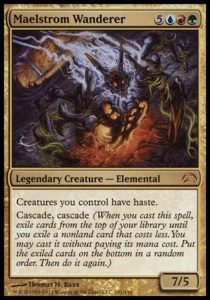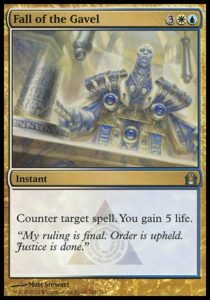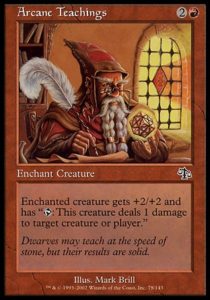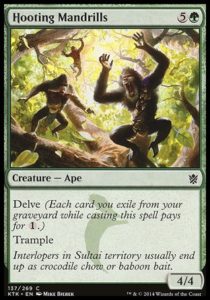Modern Masters 2017 is going to have looser themes and more multicolor support than any of the subsequent Masters products. As Sam Stoddard said, the goal is for the product to resemble Khans of Tarkir, one of the greatest Limited formats ever (in this author’s opinion, at least). However, as any cube designer knows, there’s a fine line between supporting multicolor decks and having multicolor ‘goodstuff’ decks be the only option. So, what’s the problem, and is Modern Masters likely to fall prey to it?

When everything is possible, nothing is.
People familiar with the first Legendary Cube are well aware of the problem of a cube having too much fixing and too many powerful cards not reliant on synergy. Cards like Kokusho, the Evening Star, Ulamog, the Infinite Gyre, Geist of Saint Traft, and Child of Alara are all very different cards, but they’re all finishers, designed to end the game. When finishers are plentiful and interchangeable, the actual cards themselves don’t matter—all that matters is whether you’re able to cast them. Different drafts can feel very extremely similar, because even though the cards in your deck are very different, the kinds of things your decks do are the same.
Shards of Alara, another multicolor format, also suffered from this problem. Yes, bombs weren’t nearly as prevalent as they were in Legendary Cube (and neither was fixing), but multicolored cards were disproportionately powerful and generally didn’t rely heavily on archetypes. Moreover, the set archetypes weren’t very parasitic, so Naya drafters and Esper drafters were still fighting over many white cards, even though their decks were supposed to be doing very different things. Many of the best decks were simply those which snapped up as much fixing as they could and then took whatever late strong multicolor cards came around.
TL;DR: Formats with disproportionately strong cards not reliant on synergy reward drafters who prioritize fixing highly. Such drafters maximize the number of such cards they can play. This is dangerous.
Why not Khans?
Khans of Tarkir succeeded were Shards of Alara fell short for a few reasons.
First, it had more fixing. It had ten common dual lands (which gained life, a relevant ability), five common tricolor banners, five uncommon tri-lands, and five rare fetchlands (which, at rare, didn’t help much). In addition, it had morph. Morph is a mana-smoothing and mana-fixing mechanic, allowing uncastable multicolor creatures to be Gray Ogres until you have sufficient mana (or they die).
Secondly, it had stronger themes than Shards (and Invasion) did. Yes, these were flexible, since Outlast, Prowess, Delve, Raid, and Ferocious don’t really care about what deck they’re in. Nevertheless, these mechanics signify what each color set cares about and reward you for building a deck to maximize their utility. Outlast creatures are just better when you combine Ainok Bond-Kin, Mer-Ek Nightblade, and Tuskguard Captain. Hooting Mandrills is great in any green deck, but only a Sultai deck can really afford to play several delve creatures. You could play a lot of the strongest cards in any deck, but they were often just better when you followed an archetype. This was subtle, but very, very smart design.
Thirdly, and finally, Khans of Tarkir had a very strong aggro deck. WB Warriors (and to a lesser extent, WR aggro) was there to punish a table of people fighting to out-durdle each other. Cube designers know that aggro (usually monored aggro) has to be strong enough to punish a table of people dedicated to drafting five color goofstuff.

So, how does MMA 2017 match up?
I admit, I was pretty anxious when I saw the set’s themes in Sam Stoddard’s aforementioned article:
- White-Blue Blink
- Blue-Black Instant Control
- Black-Red Unearth/Sacrifice
- Red-Green Token Go-Wide
- Green-White Populate
- Esper Control (with Creatures)
- Grixis Graveyard
- Jund Sacrifice
- Naya Token Aggro
- Bant Splicers
Or, as I’d put it:
- WU: play value creatures. Add G to continue to benefit from value creatures (but focus on token-creating splicers).
- UB: play control. Add W to continue doing that.
- BR: play with the graveyard. Add U to continue doing that.
- RG, GW: play tokens. Mix R/W to continue doing that. Also U for more tokens or B for sacrifice shenanigans.
That’s basically four archetypes, and “play value creatures” is a pretty thin one, since that’s something folks tend to do anyway. That said, a lot of the design is actually signaling that these archetypes are more distinct than they may appear and that the format is faster than those which support the slow pace multicolor goodstuff formats require. This is most apparent with cards which have been downshifted in rarity:
- Augur of Bolas is only going to be okay in most WU blink decks, since they need to be chock-full of creatures and don’t work with token-creating instants and sorceries.
- Falkenrath Noble is strong on its own but disgustingly powerful in a deck designed to work with it. It’s fine in a multicolor goodstuff deck but amazing in a well-tuned machine. Cards like this give me confidence in the designer’s attention to details. Also, cards like this at common give me the chills.
- Call of the Conclave is an aggressive beater that’s just too fast for goodstuff decks to take (or deal with). It’s also ideal for draft chaff Wake the Reflections, which stands a chance of consistently making 3/3 centaurs and golems for a single mana.
- Burning-Tree Emissary is another disgustingly powerful card which is going to creating instant armies which slow decks can’t deal with.
- Thunderous Wrath is going to murder people out of nowhere and it’ll be random and glorious.
We’ll see how the format plays, but based on the rarity-downshifted commons and uncommons—Wayfaring Temple and Gaea’s Anthem are uncommons! Lingering Souls is still an uncommon!—there’s more than enough fun police and context-sensitive cards to reward the astute drafter, rather than people just greedily taking the fixing.
That said, I freely admit I will nevertheless be the person greedily drafting all the trilands I can get my hands on—er, unless there’s a Falkenrath Noble in the pack. How is that card a common?!

May you all be masters.
That’s all for this week. I’m supremely stoked to get to play with another Modern Masters set. I’m disappointed that it won’t be supported at the Grand Prix level, but that’s not stopping me from trying to draft as much of it as I can. Here’s hoping it’s one for the Limited hall of fame, alongside Innistrad, Khans of Tarkir, and the original MMA (at least, that’s my top 3—you’re all entitled to your own).
And, as always, thanks for reading.
—Zachary Barash
Zachary Barash is a New York City-based game designer. He’s played Magic since 1994, but went on a long hiatus, like many folks. He’s currently pursuing his MFA in Game Design at NYU and designing for Kingdom Death: Monster, a game that is most definitely not Magic.


